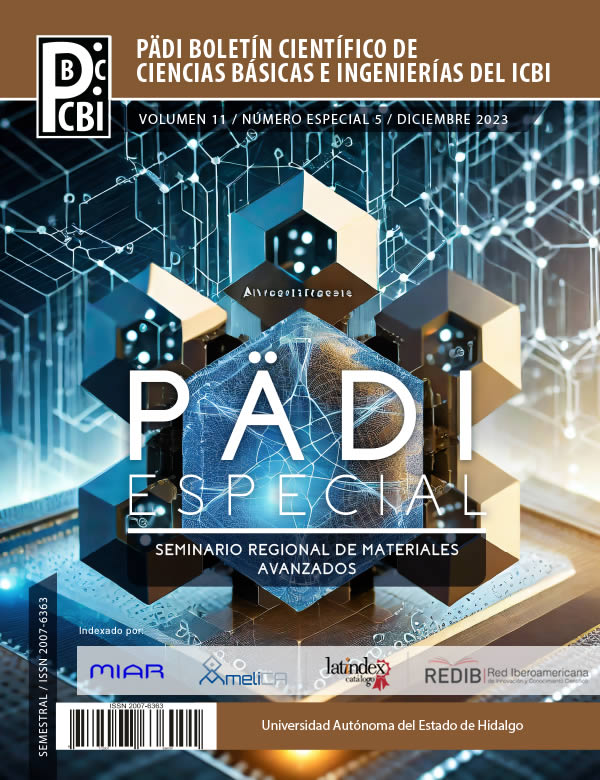Envases Tetra Pak y su uso en materiales de construcción
DOI:
https://doi.org/10.29057/icbi.v11iEspecial5.11708Palabras clave:
Tetra Pak, envases multicapa, materiales de construcción, radiación gamma, propiedades mecánicasResumen
En este trabajo de investigación, se estudiaron los efectos de añadir desechos de envases Tetra Pak en la elaboración de materiales utilizados en el área de la construcción. Los resultados demuestran que el uso de los desechos conlleva un carácter multifuncional, ya que no solo mejoran los valores de propiedades mecánicas sin la necesidad de realizar un proceso de reciclamiento o separación de sus componentes, sino que ayudan a reducir la cantidad de desechos arrojados al medio ambiente. Adicionalmente, se estudia el uso de la radiación gamma como metodología para el reciclamiento y modificación de materiales de desecho, entre ellos los envases Tetra Pak. Metodología que ofrecen considerables ventajas sobre los métodos convencionales de reciclamiento, entre estas la no generación de subproductos y/o residuos no deseados.
Descargas
Información de Publicación
Perfiles de revisores N/D
Declaraciones del autor
Indexado en
- Sociedad académica
- N/D
Citas
Askeland, D. R., & Wright, W. J. (2016). Ciencia e ingeniería de materiales. Cengage Learning. México.
Bekhta, P., Lyutyy, P., Hiziroglu, S., & Ortynska, G. (2016). Properties of composite panels made from Tetra-Pak and polyethylene waste material. Journal of Polymers and the Environment, 24: 159–165. DOI: 10.1007/s10924-016-0758-7
Brock, J. (Ed.). (2021). Gamma Irradiation: Properties, Effects and Development of New Materials. Nova Science Publishers: USA.
Callister, W. D., & Rethwisch, D. G. (2017). Materials Science and Engineering: An Introduction. Wiley: USA.
Cihad-Bal, B. (2022). Mechanical properties of wood-plastic composites produced with recycled polyethylene, used Tetra Pak® boxes, and wood flour. BioResources, 17(4): 6569-6577. DOI: 10.15376/biores.17.4.6569-6577
Dodiuk, H. (2021). Handbook of Thermoset Plastics. Elsevier Science. United Kingdom.
Dölle, K., & Kavin-Chinnathambi-Jeeva, N. (2022). Aseptic packaging container recovery – A review. Journal of Materials Science Research and Reviews, 10 (1): 38-51. http://institutearchives.uk/id/eprint/18
Drobny, J. G. (2021). Radiation Technology for Polymers. CRC Press: USA.
Ebadi, M., Farsi, M., Narchin, P., & Madhoushi, M. (2016). The effect of beverage storage packets (Tetra Pak™) waste on mechanical properties of wood–plastic composites. Journal of Thermoplastic Composite Materials, 19 (12): 1601–1610. DOI: 10.1177/0892705715618745
Foti, D., Adamopoulos, S., Voulgaridou, E., Voulgaridis, E., Passialis, C., Amiandamhen, S. O., & Daniel, G. (2019). Microstructure and compressive strength of gypsum-bonded composites with papers, paperboards, and Tetra Pak recycled materials. Journal of Wood Science, 65 (42): 1-8. DOI: 10.1186/s10086-019-1821-5
Gao, S., Li, Q. Y., & Sun, C. X. (2011). Experimental research on the durability of WPC wallboard made of paper-aluminum-plastics wastes. Materials Science Forum, 675–677: 423–425. DOI: 10.4028/www.scientific.net/msf.675-677.423
Guillén-Mallette, J., Carrillo-Baeza, J., Aranda-Ayala, A., & Rivero-Ayala, M. (2021). Optimization of processability and physical and mechanical properties of extruded polyethylene-Tetra Pak cartons composites by experimental design. Journal of Thermoplastic Composite Materials, 34(11): 1462-1487. DOI: 10.1177/0892705719873944
Hassanin, A. H., & Candan, Z. (2010). Novel bio-based composites panels from Tetra Pak waste. Key Engineering Materials, 689: 138–142. DOI: 10.4028/www.scientific.net/KEM.689.138
Harper, C. A. Handbook of Plastics Technologies: The Complete Guide to Properties and Performance. McGraw Hill LLC: Ukraine.
Khan-Rezaul, K., Shauddin, S. M., Dhar, S. S., & Khan-Mubarak, A. (2014). Comparative experimental studies on the physico-mechanical properties of jute caddies reinforced polyester and polypropylene composites. Journal of Polymer and Biopolymer Physics Chemistry, 2(3): 55-61. DOI: 10.12691/jpbpc-2-3-3
Klyosov, A. A., & Klesov, A. A. (2007). Wood-plastic composites. Wiley: United Kingdom.
Koh-Dzul, J. F., Carrillo, J. G., Guillen-Mallette, J., & Flores-Johnson, E. A. (2023). Low velocity impact behaviour and mechanical properties of sandwich panels with cores made from Tetra Pak waste. Composite Structures, 304: 1-12. DOI: 10.1016/j.compstruct.2022.116380
Kuzmin, A. M., Ayrilmis, N., Özdemir, F., & Kanat, G. (2023). Effect of content and particle size of used beverage carton pieces on the properties of HDPE composites. BioResources, 18(2): 2815-2825. DOI: 10.15376/biores.18.2.2815-2825
Macías-Gallego, S., Guzmán-Aponte, A., Buitrago-Sierra, R., & Santa-Marín, J. F. (2020). Evaluation of mechanical properties of composites manufactured from recycled Tetra Pak® containers. Tecnura, 24 (66): 36-46. DOI: 10.14483/22487638.16296
Martínez-López, M., Martínez-Barrera, G., Barrera-Diáz, C., Ureña-Nuñez, F., & Witold, B. (2015). Waste materials from Tetra Pak packages as reinforcement of polymer concrete. International Journal of Polymer Science, 2015: 1-8. DOI: 10.1155/2015/763917
Niaki, M. H., & Ahangari, M. G. (2022). Polymer Concretes, Advanced Construction Materials. CRC Press: USA. DOI: 10.1201/9781003326311
Nieves-Flores, J. J. (2015). Reciclaje mecánico y por radiación gamma de envases de Tetra Pak Brik Aseptic® para la modificación de propiedades físicas y mecánicas y su reuso como sustituto de agregado fino en concreto. Tesis de Licenciatura, UAEMex. http://hdl.handle.net/20.500.11799/32693
Ohama, Y. (2008). 12-Polymer concrete. In S. Mindess (Ed.), Developments in the Formulation and Reinforcement of Concrete (pp. 256-269). Woodhead Publishing Limited: United Kingdom. DOI: 10.1533/9781845694685.256
Parada-Soria, A., Yao, H. F., Alvarado-Tenorio, B., Sanchez-Cadena, L., & Romo-Uribe, A. (2013). Recycled HDPE-tetrapack composites: isothermal crystallisation, light scattering and mechanical properties. Mater Res Soc Symp Proc, 1485: 77–82. DOI: 10.1557/opl.2013.252
Platnieks, O., Barkane, A., Ijudina, N., Gaidukova, G., Kumar-Thakur, V., & Gaidukovs, S. (2020). Sustainable Tetra Pak recycled cellulose/poly(butylene succinate)-based woody-like composites for a circular economy. Journal of Cleaner Production, 270: 1-16. DOI: 10.1016/j.jclepro.2020.122321
Rahman, H., Alimuzzaman, S., Alamgir-Sayeed, M. M., & Amin-Khan, R. (2019). Effect of gamma radiation on mechanical properties of pineapple leaf fiber (PALF)-reinforced low-density polyethylene (LDPE) composites. International Journal of Plastics Technology, 23: 229–238. DOI: 10.1007/s12588-019-09253-4
Robertson, G. L. (2021). Recycling of aseptic beverage cartons: a review. Recycling, 6(1): 1-20. DOI: 10.3390/recycling6010020
Rowell, R. M. (2013). Handbook of Wood Chemistry and Wood Composites (Second Edition). Taylor & Francis: United Kingdom.
Salamanca-Sarmiento, J. R., & Vaca-Rodríguez, J. S. (2017). Caracterización de un material compuesto de Tetra Pak, reforzado con polietileno de baja densidad (PEBD) y conformado en prensa de calor. Ingenio Magno, 8(1): 132-147. http://revistas.ustatunja.edu.co/index.php/ingeniomagno/article/view/1394
Salazar-Jurado, E., Fonthal-Rivera, G., & Gómez-Hernández, E. (2021). A new material with low density and low




















